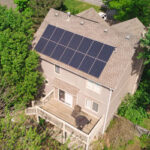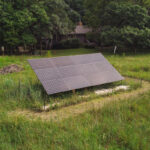Sunlight is Earth’s most abundant form of energy. It’s free, renewable and depending on where you live, easy to access for most of the year. A total of 173,000 terawatts (trillions of watts) of sunlight strikes the Earth continuously. That’s 10,000 times the energy the world actually uses. With all of this free energy hitting the surface of the Earth, it makes financial and ecological sense for us to harness it for our home, business and transportation needs. That’s where solar panels come in.
 Solar panels convert sunlight into electrical energy. They are made up of small individual cells that typically produce about 1 or 2 watts of power each. Many times these cells are made of a thin silicon film that’s about as thick as a piece of paper. When photons or light hits a solar cell, electrons are shaken loose from their atoms. If conductors are attached to the positive and negative sides of the cell, an electrical circuit is formed to allow the electrons to flow, generating electricity.
Solar panels convert sunlight into electrical energy. They are made up of small individual cells that typically produce about 1 or 2 watts of power each. Many times these cells are made of a thin silicon film that’s about as thick as a piece of paper. When photons or light hits a solar cell, electrons are shaken loose from their atoms. If conductors are attached to the positive and negative sides of the cell, an electrical circuit is formed to allow the electrons to flow, generating electricity.
Multiple cells make up a solar panel, and multiple panels (sometimes also referred to as modules) can be wired together to form a solar array. In order to withstand the outdoor elements like wind, rain, snow and extreme heat, the cells are sandwiched between protective sheets of durable glass and framed in metal, creating a solar panel. Solar panels can be placed on the roofs of buildings or installed on the ground. The more panels you can install on your home or business, the more energy you can expect to generate.

Solar panels generate direct current or DC electricity. With DC electricity, electrons flow in one direction around a circuit. Because most of the devices used in American homes or businesses run on alternating current or AC electricity, an inverter is needed. AC power often alternates in polarity, reversing positive and negative over time. A solar inverter takes the DC electricity from the solar array and uses that to create AC electricity. Inverters are like the brains of the system. Along with inverting DC to AC power, they also provide ground fault protection and system stats, including voltage and current on AC and DC circuits, energy production and maximum power point tracking.
 We measure electricity in watts. One thousand watts make up a kilowatt (kW). When you use one thousand watts of electricity in one hour, you get a measurement of kilowatt-hours (kWh). This is the measurement you commonly see on your utility bills. In 2020, the average annual electricity consumption for a U.S. residential utility customer was 10,715 kilowatt-hours (kWh), or an average of about 893 kWh per month. When designing your solar panel system, we take into account your yearly energy consumption and any special electricity needs you might have (sump pumps, refrigeration, medical equipment, electric vehicles, etc). With that information, Good Energy Solutions can create a detailed plan to help you offset your yearly energy usage.
We measure electricity in watts. One thousand watts make up a kilowatt (kW). When you use one thousand watts of electricity in one hour, you get a measurement of kilowatt-hours (kWh). This is the measurement you commonly see on your utility bills. In 2020, the average annual electricity consumption for a U.S. residential utility customer was 10,715 kilowatt-hours (kWh), or an average of about 893 kWh per month. When designing your solar panel system, we take into account your yearly energy consumption and any special electricity needs you might have (sump pumps, refrigeration, medical equipment, electric vehicles, etc). With that information, Good Energy Solutions can create a detailed plan to help you offset your yearly energy usage.
If you would like to know more about solar energy or how it can help you lower your carbon footprint, contact us. Our solar consultants can create a detailed plan that will show you how much you can save on your monthly energy bills.

